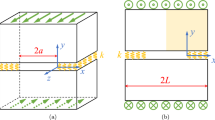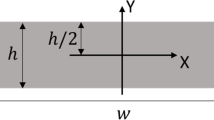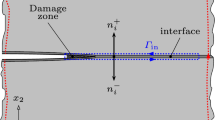Abstract
A new analytical solution in the form of asymptotic series is proposed and studied for Mode III crack problems with spring boundary conditions, which are, in the mathematically-oriented literature, referred to as Robin boundary conditions. Under the assumption of antiplane shear loading, the corresponding elastic problem reduces to the Laplace equation for the out-of-plane displacement. Numerical solutions for benchmark problems are obtained, applying the Finite Element Method, to verify this asymptotic approximation. In particular, two problems are studied, Neumann–Robin and Dirichlet–Robin. Both are used to define a partially damaged adhesive interface in which the Linear Elastic Interface Model is applied. The numerical solution is obtained using the software FEniCS, for which the variational formulation of the problem is developed. Then, it is compared to the analytical expressions proposed for the problem, computing a normalized error. Finally, a convergence analysis is presented. Several parameters, such as the stress singularity or another error measure, are used to analyse two different ways to refine the mesh.

















Similar content being viewed by others
Notes
It was created in 2003 by several universities around the world. What makes it different from other FEM software is the mathematical formulation, necessary to execute the software correctly. This formulation is implemented using Python language.
References
Alnæs, M. S., Hake, J., Kirby, R. C., Langtangen, H. P., Logg, A., Wells, G. N.: The FEniCS manual. FEniCS Project, version October 31st (2011)
Barroso, A., Cañas, J.: Uniones en estructuras aeronáuticas, uniones adhesivas y remachadas. Universidad de Sevilla, Seville (2019)
De Sterck, H., Manteuffel, T., McCormick, S., Nolting, J., Ruge, J., Tang, L.: Efficiency-based h-and hp-refinement strategies for finite element methods. Numer. Linear Algebra Appl. 15(2–3), 89–114 (2008)
Jiménez-Alfaro, S., Villalba, V., Mantič, V.: Singular elastic solutions in corners with spring boundary conditions under anti-plane shear. Int. J. Fract. 223(1–2), 197–220 (2020)
Johnson, W.S.: Adhesively Bonded Joints: Testing, Analysis, and Design, vol. 981. ASTM International, West Conshohocken (1988)
Mantič, V., Távara, L., Blázquez, A., Graciani, E., París, F.: A linear elastic—brittle interface model: application for the onset and propagation of a fibre-matrix interface crack under biaxial transverse loads. Int. J. Fract. 195, 15–38 (2015)
Massabò, R.: The bridged-crack model. Nonlinear Crack Models for Nonmetallic Materials, pp. 141–208. Springer, Dordrecht (1999)
Pantelakis, S., Tserpes, K.: Revolutionizing Aircraft Materials and Processes. Springer, New York (2020)
Perelmuter, M.: Structures with bridged cracks and weak interfaces. Proc. Struct. Integr. 13, 793–798 (2018)
Távara, L., Mantic, V., Graciani, E., Cañas, J., París, F.: Analysis of a crack in a thin adhesive layer between orthotropic materials: an application to composite interlaminar fracture toughness test. Comput. Model. Eng. Sci. (CMES) 58(3), 247–270 (2010)
Valoroso, N., Champaney, L.: A damage-mechanics-based approach for modelling decohesion in adhesively bonded assemblies. Eng. Fract. Mech. 73(18), 2774–2801 (2006)
Acknowledgements
The research was conducted with the support of the Spanish Ministry of Science, Innovation and Universities and European Regional Development Fund (Project PGC2018-099197-B-I00), and the Junta de Andalucía and European Regional Development Fund (Projects US-1266016 and P18-FR-1928). The authors also thank to the NewFrac Innovative Training Network (H2020-MSCA-ITN-2019, Ref.: 861061) for the support received.
Author information
Authors and Affiliations
Corresponding author
Ethics declarations
Conflict of interest
On behalf of all authors, the corresponding author states that there is no conflict of interest.
Additional information
Publisher's Note
Springer Nature remains neutral with regard to jurisdictional claims in published maps and institutional affiliations.
Appendix
Appendix
The recursive problems for obtaining N–R and D–R solutions are the following, for N–R
whereas for the D–R
Rights and permissions
About this article
Cite this article
Jiménez-Alfaro, S., Mantič, V. FEM Benchmark Problems for Cracks with Spring Boundary Conditions Under Antiplane Shear Loadings. Aerotec. Missili Spaz. 99, 309–319 (2020). https://doi.org/10.1007/s42496-020-00068-w
Received:
Revised:
Accepted:
Published:
Issue Date:
DOI: https://doi.org/10.1007/s42496-020-00068-w




